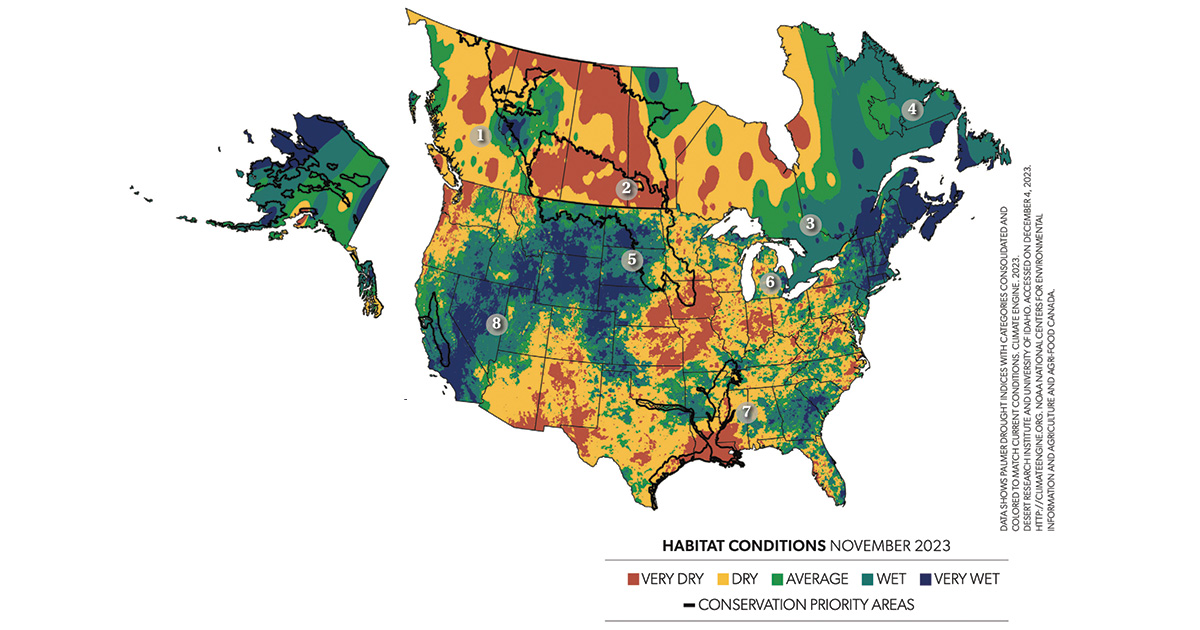Field Reports: 2024 Migration and Wintering Habitat Update
An overview of wetland conditions in key areas for waterfowl across North America
An overview of wetland conditions in key areas for waterfowl across North America
By DU Field Biologists

Along the British Columbia coast, migrating waterfowl found generally favorable habitat conditions this fall despite highly variable precipitation. In the interior and north, however, dry weather persisted, reducing water levels and impacting habitat quality. The fall migration largely concluded by late November, coinciding with freeze-up in most of the province.
After a cool October, November temperatures were above average across Prairie Canada. Precipitation was well below average in the west and north. Southern Saskatchewan and parts of Manitoba received average fall precipitation, which will hopefully allow a frost seal to form and help maximize runoff next spring. However, severe drought continues to grip the region. Water levels have receded in many wetland basins, and significant moisture will be required to recharge them next spring. The fall migration had all but wrapped up by late November, with only a few small concentrations of mallards and Canada geese remaining.

Severe drought continued to grip Prairie Canada this fall. Significant precipitation will be needed to improve conditions for breeding waterfowl next spring.
Fall precipitation ranged from near average to above average across most of Ontario and Quebec. Even in drier areas, wetlands remained at good levels thanks to ample summer rainfall. Many early migrating species, such as American green-winged teal, stopped over in the region for longer than normal this fall. Tundra swans, greater and lesser scaup, redheads, and canvasbacks began to appear on Great Lakes coastal wetlands in late October. By late November, overnight temperatures froze many shallower wetlands, pushing many migrants farther south.
Atlantic Canada was relatively warm and wet this fall with no ice cover on wetlands as of late November. Plenty of food remains in agricultural fields where harvests were delayed by wet conditions. Large numbers of Canada geese are utilizing these food sources, including waste corn and potatoes, in central Prince Edward Island. Waterfowl species, including scaup, long-tailed ducks, scoters, and goldeneyes, were observed along the coast by mid-November.
Mid-October brought frigid temperatures and variable amounts of snow to the northern plains. The cold spell froze many bodies of water and pushed waterfowl into southern portions of the region. Following the cold snap, warmer weather returned and persisted into early December. Above-average grass growth on the landscape across Montana and the Dakotas should provide good residual cover for nesting waterfowl next spring. Wetlands remain at average levels with the exception of northeast North Dakota and southeast South Dakota, where drier conditions prevail. Significant winter snowfall and spring precipitation will be required to fully recharge wetlands for the 2024 waterfowl breeding season.

While many wetland basins in the Dakotas still held water at freeze-up, additional moisture will be needed to set the stage for good waterfowl production in 2024.
A late-November storm brought freezing temperatures and the first snow of the season to the Great Lakes and northeastern United States. Areas of abnormally dry to extreme drought conditions continue to plague parts of the region. Ample winter precipitation will be needed to improve spring habitat conditions for the forthcoming breeding season.
Extreme drought continues across much of Texas and Louisiana, and salinity levels in many coastal wetlands remain above average due to a lack of freshwater inflows. November aerial waterfowl survey totals were the lowest on record for coastal Louisiana. In the Mississippi Alluvial Valley (MAV), dry conditions continue to plague the Delta, where extremely low river levels have reduced public hunting opportunities. Despite the dry weather, fair numbers of ducks and geese have reached the MAV, and good hunting has been reported on managed agricultural fields and greentree reservoirs with pumped water. The South Atlantic region is also drier than average, but flooded agricultural fields and impoundments with pumping capabilities continue to provide high-quality habitat for waterfowl, which have arrived in typical numbers.

Following last year's record drought, habitat for migrating and wintering waterfowl has improved dramatically on the Great Salt Lake and in the Central Valley of California.
Habitat conditions in the Central Valley of California are much improved over this time last year, with wetlands receiving their full water supplies and flooding of harvested rice fields progressing normally. Migration into and out of the Great Salt Lake appears to be near normal, as snowmelt this past spring also improved wetland conditions in the lake. Although habitat conditions on the Klamath Basin refuges are modestly improved over last year, the refuge’s wetlands are still closed to hunting because of a lack of water.
Ducks Unlimited uses cookies to enhance your browsing experience, optimize site functionality, analyze traffic, and deliver personalized advertising through third parties. By continuing to use this site, you agree to our use of cookies. View Privacy Policy